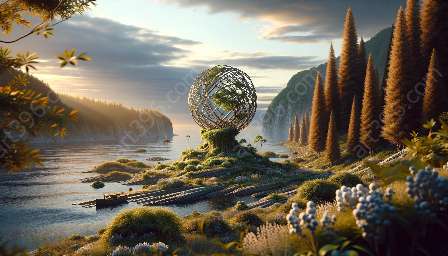Environmental art, a multidisciplinary and dynamic form of artistic expression, is deeply intertwined with the concept of collaboration. Over the course of history, collaboration has played a pivotal role in shaping the practice of environmental art, while also influencing its cultural impact and evolution.
The History of Environmental Art
Environmental art, also known as ecological art, land art, or earth art, emerged as a response to the environmental and ecological concerns of the late 1960s and early 1970s. This movement reflected artists' desire to engage with and intervene in their surroundings, encouraging a deeper connection between art and nature. Artists such as Robert Smithson, Ana Mendieta, and Andy Goldsworthy were at the forefront of this movement, utilizing natural materials and landscapes to create works that were ephemeral and site-specific.
The Birth of Collaboration in Environmental Art
From its inception, environmental art embraced collaboration as a fundamental aspect of its practice. Artists recognized the need to work hand in hand with communities, scientists, and environmentalists to address complex ecological issues through their art. This marked the birth of a collaborative approach that continues to shape the very essence of environmental art.
Collaboration as an Agent of Change
Collaboration in environmental art serves as a powerful catalyst for change. By partnering with diverse stakeholders, artists can amplify their impact and reach, creating a more significant and lasting impression on both the environment and society. Through collaborative projects, environmental artists can initiate conversations about pressing environmental concerns while fostering a sense of collective responsibility and action.
Impact on Environmental Art
The influence of collaboration on environmental art is profound. It has led to the creation of large-scale, immersive installations that engage with the environment in unprecedented ways. These collaborative endeavors often transcend traditional artistic boundaries, blurring the lines between art, activism, and environmental advocacy.
Collaboration in Practice: Case Studies
1. The Reclamation Project: Created by eco-artist Xavier Cortada, this collaborative artwork involved planting native trees in urban communities, engaging local residents and organizations to restore natural habitats.
2. The Waste to Art Initiative: Collaborating with local schools and environmental groups, artist Tom Deininger transformed marine debris into large-scale sculptures, raising awareness about ocean pollution.
3. The Greenmeme Installation: Artist Freyja Bardell collaborated with architects and environmental engineers to create sustainable public art installations that incorporated renewable energy sources and ecological materials.
Looking Ahead: The Future of Collaborative Environmental Art
The role of collaboration in environmental art continues to evolve as artists and creators strive to address the complexities of our changing planet. Moving forward, collaboration will remain a cornerstone of environmental art, shaping its trajectory and expanding its potential to effect positive change.

